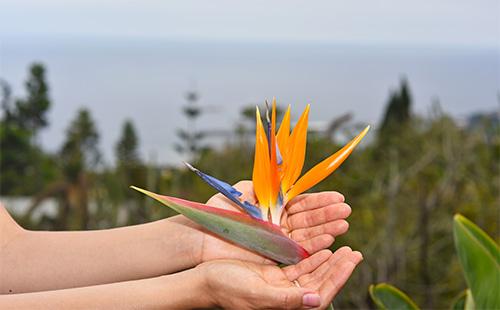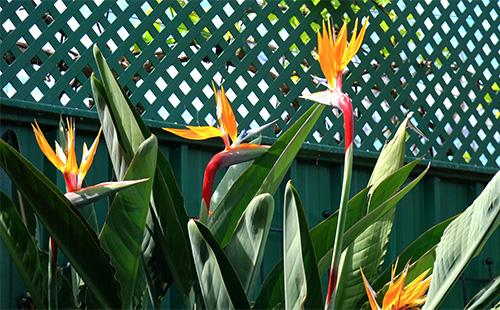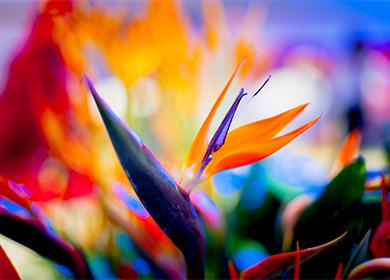The content of the article
Luxurious, elegant and exotic Strelitzia (Latin name - Strelitzia) can be rightfully put in first place in terms of flowering efficiency. And the pedigree of this unusually beautiful plant is a real monarch. A 100% African ended up in the United Kingdom more than two centuries ago: she was brought to Europe from South Africa, named for Queen of England Charlotte (nee Duchess of Mecklenburg-Strelitz), a big lover of plants. So in the world a new genus was discovered - Strelitzia and the species - royal. Somewhat later, the Russian Emperor Nicholas I received a rare Strelitzia, which looks like a banana. When the picturesque plant blossomed, it received the royal name - Nikolai.
Botanical features
Several names are known that very accurately reflect the beauty of the evergreen perennial strelitzia. So, at home she is called a crane flower, in other countries - a firebird or a bird of paradise, her original flowers are so similar to the head and tuft of a fabulous bird with bright, outlandish feathers. The plant has its own distinctive features.
- The size. In nature, Strelitzia amazes the imagination with its impressive size: its height is more than 10 m. The plant grown under indoor conditions is also far from miniature - about 2 m. True, at present, breeders have begun to display Strelitzia of a more compact size.
- Stem. Strelitzia does not have a stem as such. Leaves grow on strong petioles up to 60 cm high.
- Leaves. A powerful root system gives life to very large, fleshy, dense leaves, similar to banana leaves. Also, their shape causes associations with the oar. The color scheme is interesting: they are green with a bluish-blue coating and veins. The length of the leaves is from 30 to 200 cm, the width is 10-80 cm. They have a symmetrical fan arrangement.
- Inflorescence. Flower buds are concentrated on strong peduncles, which can be more than six. On each of them, five to seven large flowers (up to 20 cm) of the most contrasting color are revealed: orange, fiery yellow, white-blue, dark blue or purple. But the main feature is an elongated shape resembling a bird's head framed by colorful plumage from sharp petals. In indoor conditions, Strelitzia blooms continuously and abundantly (up to six months).
- Scent. Strelitzia has a strong sweet aroma that attracts pollinating birds. Attracted by the smell, the bird sits on the edge of a pointed flower, bends a few petals and gets to nectar. At this point, the stamens burst and shoot pollen on the chest of the bird. The next flower nectary fertilizes this pollen.
Kinds
The line of Strelitzians is not numerous. There are only five species of flower bird, which is a native of South Africa and Madagascar.
- Royal. The most common type of decorative strelitzia.Houses can grow up to 1.5 m. Floral orange-blue buds have a bizarre shape. Flowering does not depend on the time of year.
- Nicholas. Also called "Natal banana" for the identity of the leaves. In the process of growth, it can turn into a tree up to 10 m high. Under greenhouse conditions, it is grown to cut flowers, its large, white-blue inflorescences are so beautiful. This variety is rarely purchased for home. Looks harmoniously in large rooms and halls.
- August Height is up to 2 m, it has light green leaves up to 1 m long. Blue-gray flowers are framed by snow-white petals. The plant grows well in the garden.
- Reed. The most drought-resistant, it easily tolerates sharp temperature fluctuations and even slight frost. Flowers practically do not differ from royal strelitzia, but narrow leaves are exact reeds.
- Mountainous. It grows to 10 m. It has impressive size leaves and huge flowers in white, purple and violet tones. In home floriculture, such a strelitzia is a rare instance. It successfully grows in greenhouse conditions.
Optimum microclimate
The bird of paradise is not at all capricious, but there are still some nuances in matters of its content. The rules of additional nutrition, watering, organization of the rest period and summer pastime depend on seasonality. The maximum task is to achieve the flowering of this original plant. Indeed, few flower growers manage to realize their dream and wait for the birds of paradise to blossom. The conditions that are necessary for the comfortable development of the flower can be found in the following table.
Table - Features of the microclimate comfortable for Strelitzia
| Season | Temperature | Illumination | Humidity |
|---|---|---|---|
| Spring | 20-22 ° C (Need frequent airing) | Bright (A little morning direct sun, the windows are dull) | 70% |
| Summer | Up to 27 ° C (Requires more moisture, permissible moving to a balcony and landing in open ground) | Artificial shadow in the heat | |
| Autumn | 20-22 ° C (For New Year's flowering, an artificial sharp temperature drop is needed) | Artificial light in low light | 60% (maximum) |
| Winter | 12-16 ° C (Ideally 14 ° C, at higher temperatures, wintering may not bloom in spring) |
In spring and summer, to maintain the optimal humidity level will help:
- frequent watering;
- good drainage;
- quick drying earth mix;
- spraying leaves (not flowers);
- shower;
- moistened peat;
- moss in the pan;
- stand with wet expanded clay or pebbles;
- miniature fountain;
- humidifier.
In autumn and winter you need:
- water Strelitzia once a decade;
- constantly maintain a humid atmosphere;
- wipe the leaves once a week;
- spray (standing water at room temperature or slightly warmer);
- exclude proximity to heating appliances.
Activities after the purchase
First of all, when acquiring a flower, carefully examine it. It is recommended to buy specimens with slightly swollen or ajar buds, from which the petals have already hatched. It is to such a plant that an adaptation period will easily pass.
Strelitzia enters domestic conditions from hot countries, where it is grown from seeds and brought in shipping pots. At home, the plant must be transplanted immediately, using the method of transshipment. To do this gently and not damage the juicy, but brittle roots, cut the pot with scissors. If the root breaks off during transshipment, the wound is sprinkled with activated or charcoal.

Features of flowering
The appearance of inflorescences is a long-awaited event for strelitzia owners. With all the efforts and the best care, it will not bloom before four, and in some cases even eight years. During this period, all five conditions must be observed if possible.
- Maturity. "Adulthood" Strelitzia from four years and more.
- Leaves. A sufficient number of strong, dense leaves.
- Strong rootb. Dense, powerful roots, the appearance of young growth (new shoots).
- Cool. During the rest period, it is necessary to ensure a temperature of no higher than 16 ° C.
- A lot of light. Normal illumination for at least half a day.
If not blooming
In this case, shake the flower. As one of the options, you can simply extract the plant from the pot and leave it in this form for about a month in a darkened room. After transplanting, it blooms after a month and a half.
When choosing a more gentle stressful option, you need to take the plant to a bright balcony with an air temperature of no higher than 12-14 ° C in early spring and limit watering to a minimum. After a month, the pot must be returned to a warm room (20-22 ° C), add watering and feed. To Strelitzia pleased with blooming for the New Year holidays, a similar procedure will have to be done in the fall.
Transplant technique and fertilizer
Young plants are transplanted every spring, and sometimes twice a year. Adult Strelitzia is transplanted if necessary, most often just update a few centimeters of upper soil.
The flower itself tells you when to transplant it: its roots grow in the drainage holes and seem to drive out the strelitzia from the pot. The roots should not be crowded, so at each transplant, choose a more spacious pot.
Soil mix options
The Strelitzia mud mix is nutritious, fertile. The following four compounds can be used.
- Option number 1. Shop soil for flowering plants, in which moss, sand and humus are added equally.
- Option number 2. In equal parts: leaf and turf land, humus, peat, river sand and moss.
- Option number 3. Two parts of turfy land. Sand, peat and humus - in one piece.
- Option number 4. In equal proportions, leafy land, peat, split bark, chopped moss and a small amount of coarse river sand.
Transshipment
Before transplanting, water the plant well. The earthen lump must be completely wet so that the roots become elastic. This will protect them from breaking off. As already mentioned above, the relocation technique is used for Strelitzia. Follow the instructions in eight steps.
We transplant
- We prepare and disinfect soil, drainage and capacity.
- Put drainage on the bottom of the pot.
- With a knife, gently separate the lump of earth from the inner walls of the pot.
- We trim the roots sprouted into the drainage holes.
- Gently pull out the flower with a lump.
- We examine the roots for damage, remove rot, sprinkle the slices with crushed coal.
- We transship the plant into a new, more spacious pot, set in the center, fall asleep with soil and rammed.
- Water the soil. If it settles heavily, we add more. A pot with large plants should not be filled with earth to the very edges for the convenience of replacing the top layer.
Top dressing
Top dressing is applied to the soil every decade in the spring-summer period. For young Strelitzia, fertilizers with a high nitrogen content are good for stimulating leaf growth. Adult plants that are to bloom need to be fed with phosphorus-potassium fertilizers. In autumn and winter, no top dressing is carried out, peduncles are cut off at rest.
Breeding
Strelitzia can be grown from seeds or lateral shoots (vegetative method). In the second case, to plant a flower, you will need a plant no younger than seven years old, with a young shoot.
Seeds
Specificity. Strelitzia seeds quickly lose their germination capacity, so they use only fresh seeds no older than a year.
Execution technique
- Soak the seeds for at least two hours, maximum for a day in hot water (35-40 ° C). A thermos is good for these purposes.
- We remove the remaining fiber from the seeds.
- With prepared soil, fill 2/3 of the volume of a small pot, after making drainage holes in it.
- We moisten the soil, add river sand and place the seeds in the mixture to a depth of not more than 2 cm.
- We cover the container with a film to create a greenhouse effect.
- Crops put in a warm, shaded place.
- A home-made greenhouse until the emergence of seedlings open only for watering.
- Regularly water the seedlings with warm boiled water.
Vegetatively
Specificity. During the vegetative propagation of Strelitzia, its shoots are planted and rooted. Flowering occurs earlier than when propagated by seeds. In addition, a plant grown in this way retains maternal traits.
Execution technique
- We fill the prepared soil in pots with a diameter of up to 20 cm.
- Separate young sockets from a common rhizome with a sharp knife.
- Sprinkle the slices with charcoal “powder”.
- After planting, we do not tamp the ground to avoid injuring the roots.
- After rooting, leave the plants in the same pots until there is room for root development.

Diseases and Pests
Proper care is a guarantee of plant health. Strelitzia has a fairly strong immunity and with proper maintenance does not get sick at all. But if you are concerned about unusual symptoms in the "behavior" of Strelitzia, try to make a diagnosis as quickly as possible, identify the disease and begin treatment. This will help the table.
Table - Errors of Strelitzia care and elimination of their consequences
| Symptoms | Diagnosis | Treatment |
|---|---|---|
| Leaves darken, petioles rot | - excess moisture; - low temperature; - fungus | - Regulation of watering (lower temperature - less water); - cleaning plants from infected areas; - processing of slices with coal, and rhizomes with fungicide |
| Leaves dry at the edges | Dry air | - Irrigation of foliage (especially on hot noon); - the use of auxiliary methods of moisturizing |
| Leaves turn yellow | - Low temperature; - lack of nutrients | - Moving to a lighter and warmer place; - regular top dressing |
| Buds are poorly developed and die | After the formation of flower buds, Strelitzia was moved | Do not touch during the formation of peduncles |
| Leaves become ugly, warp and curl. | Not enough light, minerals | - Creation of bright light; - providing additional power |
| Flower has stopped growing | Rooted closely in a small pot | Transplanting into a larger pot with new soil |
| The foliage became bright spots, began to shine brightly and wilted | Thrips | - Removal of diseased leaves; - frequent washing; - insecticide treatment |
| Small pale spots, spider masses appeared | Spider mite | - The destruction of the pest with a warm shower; - processing means "Actellic" |
| There were hard spots of yellow and brown color, there are sticky discharge turning into a white coating | Shield | - Removing the pest with a sponge; - foam treatment with laundry soap; - processing with Confidor or Aktara repetition after 3 weeks |
Properly planted, healthy Strelitzia holds its shape well, its leaves stretch upward, the bush does not fall apart and remains compact. Use a support to help keep the foliage upright. It can be purchased or made with your own hands.

